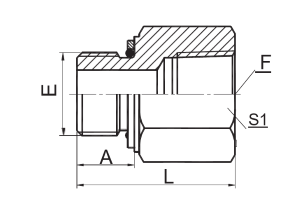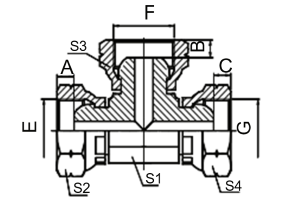When it comes to plumbing, hydraulics, and various other industries that rely on fluid systems, understanding thread standards is paramount. Two commonly encountered thread standards are NPT (National Pipe Thread) and BSP (British Standard Pipe). In this comprehensive guide, we will unravel the mysteries surrounding these two thread standards and answer the burning questions: Is NPT the same as BSP? and Is BSP compatible with NPT?
NPT: National Pipe Thread
What Is NPT?
NPT, or National Pipe Thread, is a widely used thread standard in the United States. It is known for its tapered threads that create a tight seal when assembled. NPT threads come in various sizes, typically designated by NPT followed by a number, such as NPT 1/4 or NPT 1/2. These threads are measured in inches, making them distinct from metric threads.
Characteristics of NPT Threads
NPT threads have some unique characteristics:
Tapered Threads: The threads on NPT fittings are tapered, meaning they get larger in diameter as they move away from the fitting’s end. This tapering design assists in creating a secure, leak-free seal.
Thread Angle: NPT threads have a thread angle of 60 degrees.
Sealant Required: To achieve a reliable seal, NPT threads often require the use of thread sealant or tape.
BSP: British Standard Pipe
What Is BSP?
BSP, or British Standard Pipe, is a thread standard predominantly used in Europe, including the United Kingdom. Unlike NPT threads, BSP threads are parallel, which means they maintain the same diameter throughout their length. BSP threads are denoted by a nominal size in inches, such as 1/4″ or 1/2″.
Characteristics of BSP Threads
BSP threads have distinct characteristics that set them apart:
Parallel Threads: BSP threads are parallel, providing consistent diameter from start to finish.
Thread Angle: BSP threads have a thread angle of 55 degrees.
Sealant Usage: While NPT threads often require sealant, BSP threads typically do not need additional sealant due to their parallel design.
Is NPT the same as BSP?
No, NPT and BSP threads are not the same. They differ in several key aspects, including their taper, thread angle, and usage. NPT threads are tapered with a 60-degree thread angle, while BSP threads are parallel with a 55-degree thread angle.
Is BSP compatible with NPT?
While NPT and BSP threads have distinct characteristics, it is possible to make them compatible with each other. However, it requires the use of adapters or fittings specifically designed to bridge the gap between these two thread standards. These adapters are engineered to provide a reliable connection between NPT and BSP components.
Practical Considerations
When working with NPT and BSP threads, here are some practical considerations:
Compatibility: Ensure you have the right adapters or fittings if you need to connect NPT and BSP components.
Sealant: Use the appropriate thread sealant or tape for NPT threads to prevent leaks.
Thread Measurement: Pay close attention to thread sizes, as NPT is measured in inches, while BSP is also designated in inches but follows a different naming convention.
Thread Angle: Be aware of the thread angle difference, which can affect the compatibility and sealing properties of the threads.
Conclusion
While NPT and BSP threads are distinct standards with different characteristics, they can be made compatible through the use of adapters or fittings. Understanding the differences and similarities between these thread standards is essential for anyone working with plumbing or hydraulic systems that involve components from different regions.
Post time: Sep-21-2023



